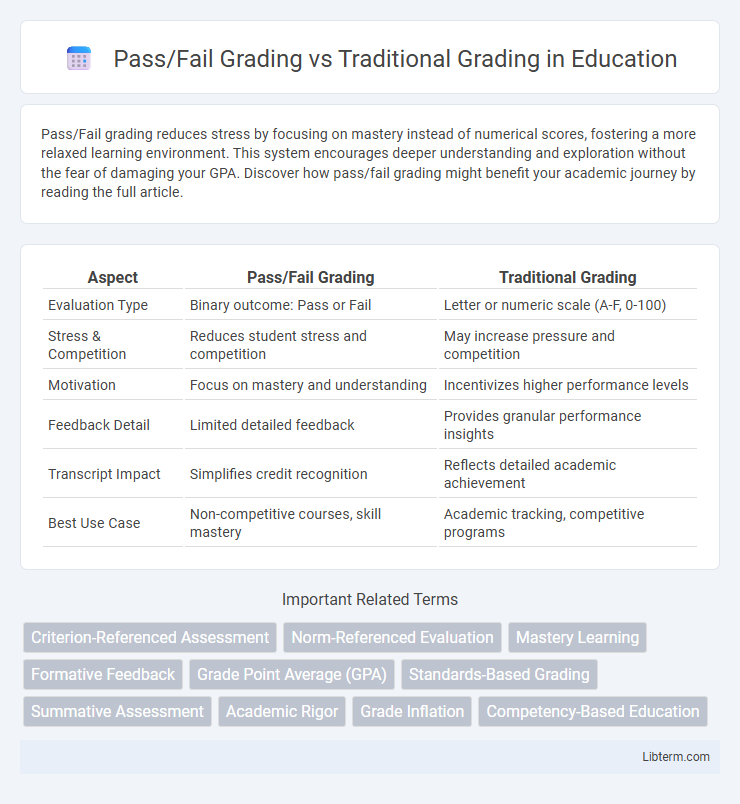Pass/Fail grading reduces stress by focusing on mastery instead of numerical scores, fostering a more relaxed learning environment. This system encourages deeper understanding and exploration without the fear of damaging your GPA. Discover how pass/fail grading might benefit your academic journey by reading the full article.
Table of Comparison
| Aspect | Pass/Fail Grading | Traditional Grading |
|---|---|---|
| Evaluation Type | Binary outcome: Pass or Fail | Letter or numeric scale (A-F, 0-100) |
| Stress & Competition | Reduces student stress and competition | May increase pressure and competition |
| Motivation | Focus on mastery and understanding | Incentivizes higher performance levels |
| Feedback Detail | Limited detailed feedback | Provides granular performance insights |
| Transcript Impact | Simplifies credit recognition | Reflects detailed academic achievement |
| Best Use Case | Non-competitive courses, skill mastery | Academic tracking, competitive programs |
Introduction to Grading Systems
Pass/Fail grading systems simplify academic evaluation by categorizing student performance into two outcomes, reducing stress and encouraging risk-taking in learning. Traditional grading systems assign letter grades or percentages that offer detailed feedback but can increase pressure and competition among students. Understanding these systems is crucial for educators and institutions aiming to balance fair assessment with student well-being.
What is Pass/Fail Grading?
Pass/Fail grading is an assessment system where students receive either a "Pass" or "Fail" instead of traditional letter grades, focusing on mastery of course material rather than numerical scores. This method reduces academic pressure by eliminating detailed performance distinctions, promoting learning and comprehension over competition. Pass/Fail grading is often used in medical schools, professional programs, and during extraordinary circumstances like the COVID-19 pandemic to support student well-being.
Overview of Traditional Grading Methods
Traditional grading methods rely on letter grades (A-F) or numerical scores to evaluate student performance, providing a detailed spectrum of academic achievement. These methods emphasize standardized assessments, quizzes, and assignments to differentiate levels of mastery and rank students comparatively. The system often impacts GPA calculations, college admissions, and scholarship opportunities, reinforcing a competitive academic environment.
Academic Performance: Measuring Effectiveness
Pass/Fail grading systems reduce student stress and encourage risk-taking in learning, though they may hinder precise assessment of academic performance compared to traditional letter grading. Traditional grading provides detailed feedback through GPA, aiding in academic benchmarking and scholarship eligibility. Studies show mixed results, with pass/fail benefiting mental health but traditional grading offering clearer metrics for evaluating academic achievement.
Student Motivation and Stress Levels
Pass/Fail grading systems significantly reduce student stress levels by eliminating the pressure to achieve high letter grades, fostering a more supportive learning environment that emphasizes mastery over competition. Traditional grading often increases motivation through tangible goal setting, but it can also elevate anxiety and diminish intrinsic interest in the subject matter. Studies indicate that pass/fail grades promote motivation driven by personal growth and understanding, while conventional grades may trigger extrinsic motivation linked to GPA and academic rankings.
Impact on Mental Health
Pass/Fail grading systems significantly reduce academic stress and anxiety by removing the pressure of achieving precise letter grades, fostering a healthier learning environment. Traditional grading often exacerbates mental health issues such as test anxiety and burnout due to its competitive nature and emphasis on high performance. Studies indicate that students under pass/fail schemes report lower levels of depression and improved overall well-being compared to those evaluated with conventional letter grades.
Flexibility and Adaptability in Learning
Pass/Fail grading systems offer greater flexibility by reducing pressure on students to achieve specific letter grades, allowing them to focus on mastering content and exploring diverse subjects. This adaptability supports personalized learning paths, accommodating different paces and styles without the stress of traditional performance metrics. Traditional grading, while structured and standardized, may limit students' willingness to take risks or engage deeply when confronted with fixed expectations and stringent evaluations.
Graduate School and Career Implications
Pass/fail grading in graduate school can reduce stress and encourage mastery-based learning but may limit detailed academic performance insights critical for competitive career paths and doctoral admissions. Traditional grading provides a nuanced evaluation of student competencies, aiding employers and academic committees in assessing applicants' strengths and readiness for research or professional roles. Choosing between grading systems impacts transcript interpretation, scholarship eligibility, and long-term career trajectory in academia and industry.
Equity and Fairness in Assessment
Pass/Fail grading systems promote equity by reducing performance anxiety and minimizing cultural and socioeconomic biases inherent in traditional letter grades. Traditional grading often reinforces disparities by privileging students with access to resources, while pass/fail assessments focus on mastery and learning progress for all students. This approach enhances fairness by accommodating diverse learning styles and reducing inequities linked to standardized grading metrics.
Choosing the Right Grading System
Choosing the right grading system involves evaluating the impact on student motivation and academic performance; Pass/Fail grading reduces stress and encourages risk-taking in learning, while Traditional Grading provides detailed performance feedback crucial for competitive programs. Institutions must consider factors such as course objectives, student diversity, and long-term academic goals when deciding between Pass/Fail and Traditional Grading. Data from educational research indicates that blending both systems in different contexts can optimize student outcomes and equity.
Pass/Fail Grading Infographic

 libterm.com
libterm.com